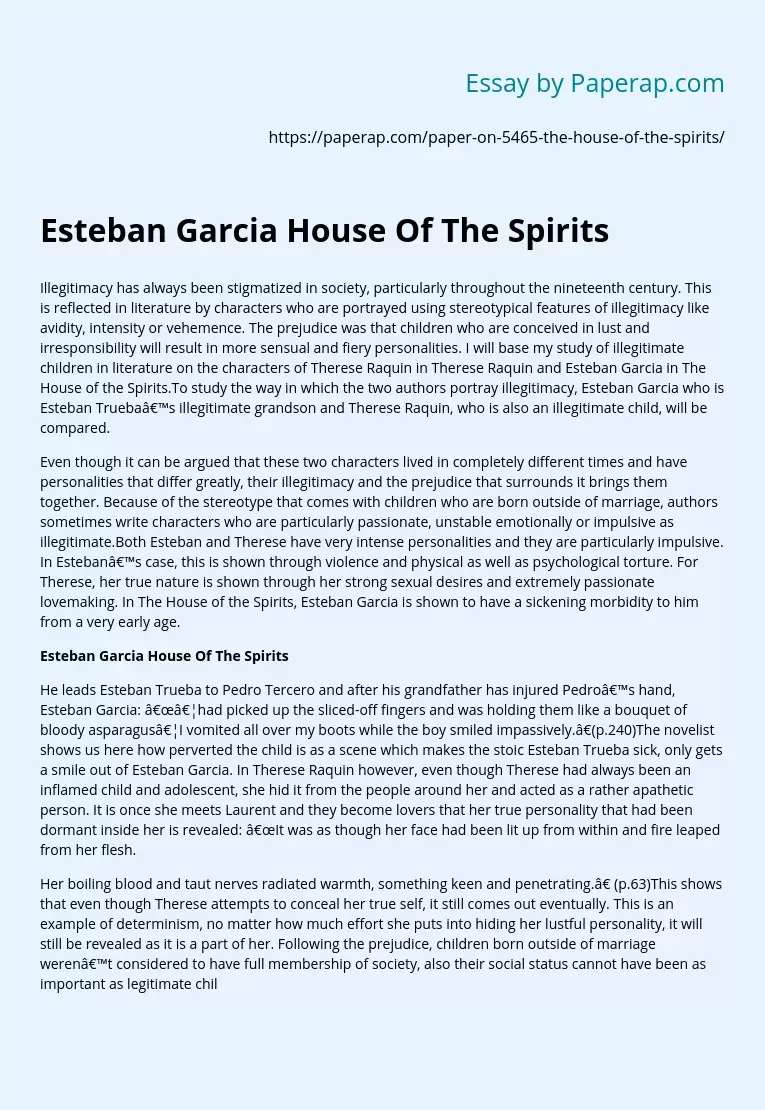Stigma of Illegitimacy in 19th Century Society
This is reflected in literature by characters who are portrayed using stereotypical features of illegitimacy like avidity, intensity or vehemence. The prejudice was that children who are conceived in lust and irresponsibility will result in more sensual and fiery personalities. I will base my study of illegitimate children in literature on the characters of Therese Raquin in Therese Raquin and Esteban Garcia in The House of the Spirits.To study the way in which the two authors portray illegitimacy, Esteban Garcia who is Esteban Trueba’s illegitimate grandson and Therese Raquin, who is also an illegitimate child, will be compared.
Even though it can be argued that these two characters lived in completely different times and have personalities that differ greatly, their illegitimacy and the prejudice that surrounds it brings them together. Because of the stereotype that comes with children who are born outside of marriage, authors sometimes write characters who are particularly passionate, unstable emotionally or impulsive as illegitimate.Both Esteban and Therese have very intense personalities and they are particularly impulsive.
In Esteban’s case, this is shown through violence and physical as well as psychological torture. For Therese, her true nature is shown through her strong sexual desires and extremely passionate lovemaking. In The House of the Spirits, Esteban Garcia is shown to have a sickening morbidity to him from a very early age.
He leads Esteban Trueba to Pedro Tercero and after his grandfather has injured Pedro’s hand, Esteban Garcia: “…had picked up the sliced-off fingers and was holding them like a bouquet of bloody asparagus…I vomited all over my boots while the boy smiled impassively.
”(p.240)The novelist shows us here how perverted the child is as a scene which makes the stoic Esteban Trueba sick, only gets a smile out of Esteban Garcia. In Therese Raquin however, even though Therese had always been an inflamed child and adolescent, she hid it from the people around her and acted as a rather apathetic person. It is once she meets Laurent and they become lovers that her true personality that had been dormant inside her is revealed: “It was as though her face had been lit up from within and fire leaped from her flesh.
Her boiling blood and taut nerves radiated warmth, something keen and penetrating.” (p.63)This shows that even though Therese attempts to conceal her true self, it still comes out eventually. This is an example of determinism, no matter how much effort she puts into hiding her lustful personality, it will still be revealed as it is a part of her. Following the prejudice, children born outside of marriage weren’t considered to have full membership of society, also their social status cannot have been as important as legitimate children.As it was considered that illegitimate children were closer to animals than proper human beings, they were expected to be more prone to mental ilnesses or being emotionally unstable. Perhaps this was because being seen as an outsider brought on frustration and resent towards society.
In The House of the Spirits, Esteban Garcia clearly demonstrates resent as he speaks of Alba as “She embodied everything he would never have…”(p.328) :”He, barefoot in the mud, swore that one day he would make her pay for her arrogance and avenge himself for his cursed bastard fate.” (p.469) Esteban Garcia kept to his promise and later on tortured and sexually abused Alba for weeks. In Therese Raquin, this kind of lower status is also seen. The novelist sometimes describes Therese as he would a domestic animal. She sounds like a type of apathetic pet who lacks a soul and personality: “She had always shown such passive obedience that her aunt and husband no longer bothered to ask her opinion. She went where they went, did what they did, without a word of complaint or reproach, without even appearing to notice that she was moving at all.” (p.43)It is as though the Raquin family had adopted a wild beast and tamed it into a pet.
Zola does however, reveal Therese’s true impulsive nature by sudden outbursts. He emphasises these using a lot of animal imagery. This is again an example of determinism. At unexpected times, Therese uncontrollably lets her instinctual side show: “One day he (Camille) gave her a push and knocked her over : she leaped to her feet like a wild beast and with face aflame and bloodshot eyes flew at him with both arms raised.” (p.41)Events like these reinforce the portrayal of Therese as a wild spirit trapped inside a passive woman’s body. Comparably, in The House of the Spirits, Esteban Garcia is sometimes described using animal imagery and seen by other characters to have beast like features. Particularly Alba, who was inflicted by most of his violence and torture.
After Esteban forcefully kissed her on her fourteenth birthday Alba is traumatized and even has nightmares: “She told no one of that repulsive kiss or of the dreams that she had afterward, in which Garcia appeared as a green beast that tried to strangle her with his paws and asphyxiate her by shoving a slimy tentacle down her throat.” (p.374)The way Alba sees Esteban Garcia only emphasises Allende’s character as being particularly violent, repulsive and brutal. Therese and Esteban’s sexual attitude also reveals their instinctive, almost subhuman selves. They both have an enormous apetite for sex and prove to be near savage in practice. In The House of the Spirits, Esteban comes across as sadistic when he fantasises about Alba as she is sitting on his lap:
Stigma of Illegitimacy in 19th Century Society. (2019, Dec 05). Retrieved from https://paperap.com/paper-on-5465-the-house-of-the-spirits/

